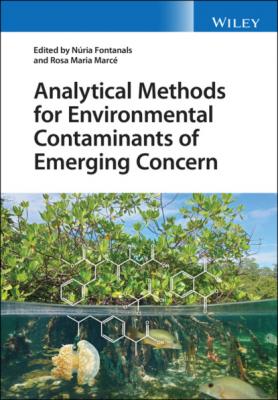Analytical Methods for Environmental Contaminants of Emerging Concern. Группа авторов
Читать онлайн.| Название | Analytical Methods for Environmental Contaminants of Emerging Concern |
|---|---|
| Автор произведения | Группа авторов |
| Жанр | Химия |
| Серия | |
| Издательство | Химия |
| Год выпуска | 0 |
| isbn | 9781119763888 |
16 Index
List of Illustrations
1 Chapter 1Figure 1.1 Forty-five TPs originating from...Figure 1.2 Metabolite behavior according to the...Figure 1.3 Neonicotinoid insecticides in the environment...Figure 1.4 Pesticide families detected in (A...Figure 1.5 Chromatograms of the targeted pesticides...
2 Chapter 2Figure 2.1 Selected properties of pharmaceuticals.
3 Chapter 3Figure 3.1 Pathways of personal care products...
4 Chapter 4Figure 4.1 Number of NPS reported to...
5 Chapter 6Figure 6.1 Biotransformation pathway of FTOH-based...Figure 6.2 Occurrence of PFASs in the...Figure 6.3 Collision-induced dissociation (CID) mass...Figure 6.4 Negative-ion APPI mass spectra...Figure 6.5 Smartphone app-based sensor for...
6 Chapter 7Figure 7.1 General chemical structure of some...Figure 7.2 Phthalate metabolites pathway (A); structure...
7 Chapter 9Figure 9.1 The redox states of halobenzoquinones.
8 Chapter 10Figure 10.1 Scheme of the most commonly...
List of Tables
1 Chapter 1Table 1.1 Overview of analytical methods...Table 1.2 Overview of analytical methods...Table 1.3 Overview of analytical methods...Table 1.4 Overview of analytical methods...
2 Chapter 2Table 2.1 Pharmaceuticals and their selected...Table 2.2 Exemplary extraction/clean-up...Table 2.3 GC/MS application for...Table 2.4 LC/MS application for...
3 Chapter 3Table 3.1 Analytical methods for UV...Table 3.2 Analytical methods for preservatives...Table 3.3 Analytical methods for plasticizers...Table 3.4 Analytical methods for fragrance...
4 Chapter 4Table 4.1 NPS categories present in...Table 4.2 Summary of different analytical...Table 4.3 Analytical methods used for...
5 Chapter 5Table 5.1 Structure and physicochemical properties...Table 5.2 NORMAN lowest PNECs for...Table 5.3 Occurrence data of ASs...Table 5.4 Most frequently used SPE...Table 5.5 Stationary and mobile phases...Table 5.6 MRM transitions of AS...Table 5.7 Figures of merit of...
6 Chapter 6Table 6.1 List of poly- and...Table 6.2 Characteristics of poly- and...
7 Chapter 7Table 7.1 Examples of HPVCs and...Table 7.2 Overview of analytical methods...Table 7.3 Analytical methods to determine...Table 7.4 Analytical methods to determine...Table 7.5 Overview of analytical methods...Table 7.6 Overview of analytical methods...
8 Chapter 8Table 8.1 Classification and physicochemical properties...Table 8.2 Overview of analytical methods...Table 8.3 Overview of analytical methods...
9 Chapter 9Table 9.1 Main physical-chemical properties...Table 9.2 Main physical-chemical properties...Table 9.3 Main physical-chemical properties...Table 9.4 Main physical-chemical properties...Table 9.5 Main physical-chemical properties...Table 9.6 Main physical-chemical properties...Table 9.7 Main physical-chemical properties...Table 9.8 Main physical-chemical properties...Table 9.9 Parametric (*) and guideline values...Table 9.10 Parametric (*) and guideline values...Table 9.11 Columns and conditions used...Table 9.12 Columns and conditions used...Table 9.13 Columns and conditions for...Table 9.14 Columns and conditions used...Table 9.15 Limit of detection of...
10 Chapter 10Table 10.1 Average items detected in...
Guide
1 Cover
5 Preface
6 Table of Contents
8 Index
Pages
1 i
2 ii
3 iii
4 iv
5 v
6 vi
7 vii
8 viii
9 ix
10 x
11 xi
